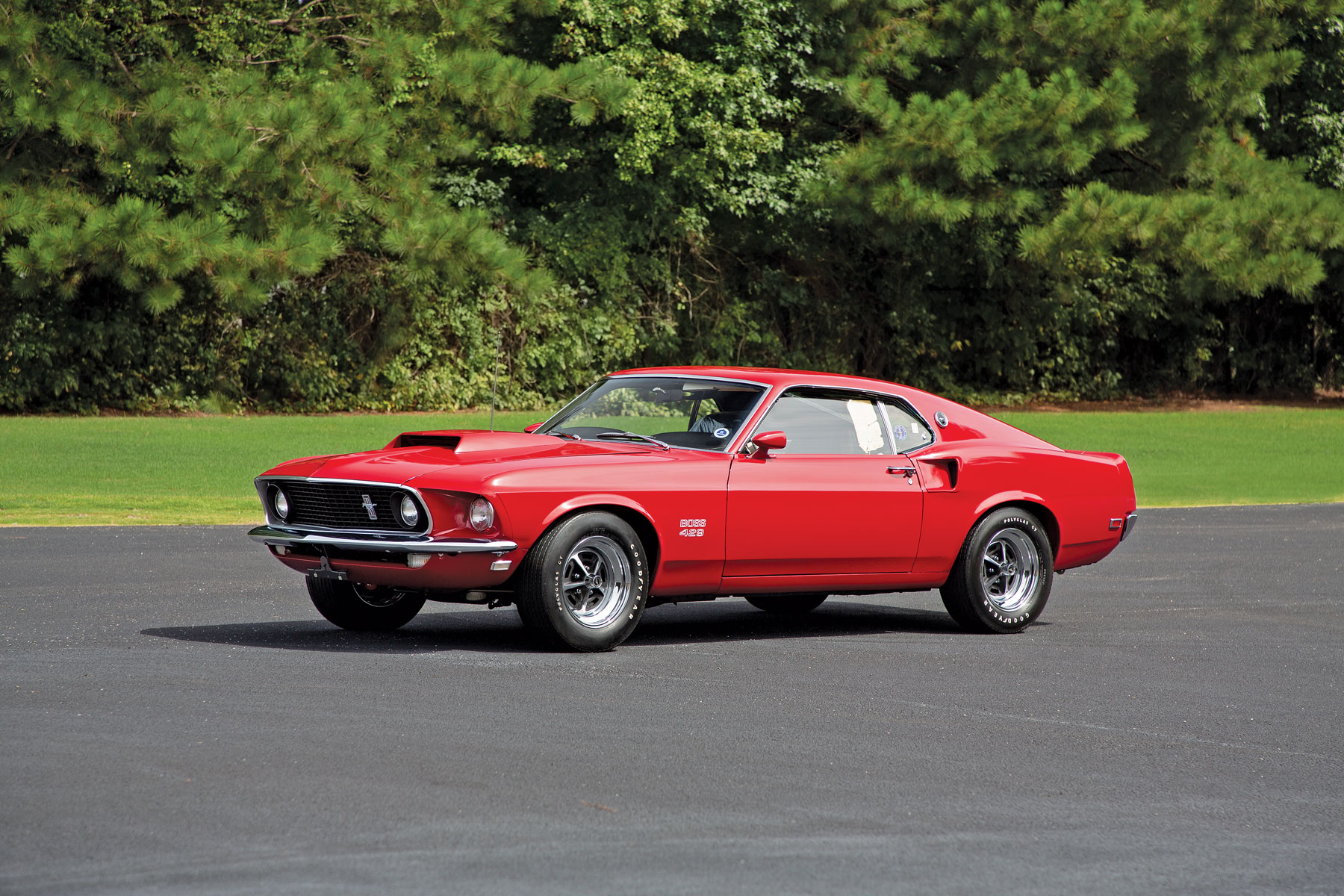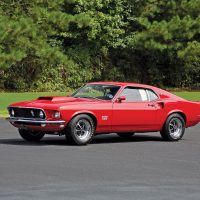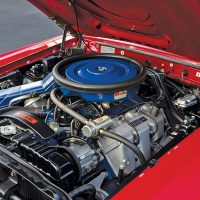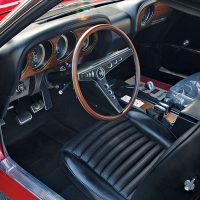- 429-ci OHV Q-code V8
- Holley 735 CFM 4-barrel carburetor
- 375 hp at 5,600 rpm
- 4-speed close-ratio manual transmission
- Competition coil-spring front suspension with Traction-Lok differential
- Less than 3,500 original miles
- Restoration by marque expert Bob Perkins
- Multiple award winner including Mustang Club of America “Triple Crown” in 1990
- Extremely well documented with original window sticker, Kar-Kraft inspection report and Marti Report
SCM Analysis
Detailing
| Vehicle: | 1969 Ford Mustang Boss 429 |
| Years Produced: | 1969 |
| Number Produced: | 859 |
| SCM Valuation: | $231,000 |
| Tune Up Cost: | $250 |
| Chassis Number Location: | Tag under windshield; Kar-Kraft number tag on driver’s door |
| Engine Number Location: | Front right-hand cylinder bank |
| Club Info: | Mustang Club of America |
| Website: | http://www.mustang.org |
| Alternatives: | 1969–70 Chevrolet Camaro Z28, 1968–70 Dodge Hemi Charger, 1970 Plymouth Hemi ’Cuda |
| Investment Grade: | A |
 This car, Lot 318, sold for $346,000, including buyer’s premium, at Bonhams’ Simeone Foundation Automotive Museum sale, held in Philadelphia, PA, on October 11, 2020.
This car, Lot 318, sold for $346,000, including buyer’s premium, at Bonhams’ Simeone Foundation Automotive Museum sale, held in Philadelphia, PA, on October 11, 2020.
Looking at the 1969 Mustang sales brochure, you’d think the last thing Ford’s Pony car needed was more models and more engine options. Reflecting Ford’s “Mustang for everyone” concept — from secretaries to SCCA racers — the line included hard tops, fastbacks (called “SportsRoofs” by Ford) and convertibles. New to the range were luxurious Grande hard tops and performance-luxury Mach-1 fastbacks. Buyers could choose from eight engines ranging from a 115-horsepower, 200-cid inline 6 to the 335-hp, 428-cid Cobra Jet Ram-Air V8. That impressive lineup didn’t even include the restyled Shelbys.
By the middle of the model year, the Mustang herd got larger with the introduction of the Boss 302, a street version of the Trans Am race car, and the Boss 429 — the “NASCAR Mustang.”
A Boss for the boss
The management world of Detroit was surprised in early 1968 when longtime GM executive Simon “Bunkie” Knudsen was named president of Ford. Knudsen was a “car guy,” credited with starting Pontiac’s performance era, and introducing the Super Sport models as general manager of Chevrolet.
About this time, Ford engineers were finishing the development of a new 429-cid “Semi-Hemi” NASCAR motor designed to replace the 427/428 FE-block, which had seen success everywhere from dragstrips to Le Mans. Although the new engine would race in midsize Torinos, it was decided to offer it in Mustangs to meet NASCAR’s 500-unit production-engine homologation rule. In detuned street guise, it was conservatively rated at 375 hp to appease the insurance industry, a healthy bump over the 335 hp produced by the 428 Cobra Jet. With tuning, it could produce around 500 hp, and with race modifications, even more.
Knudsen saw the Boss 429 as the ultimate Mustang, and he wanted to reassert Ford’s dominance in the performance-car wars against Mopar Hemis and Chevy big blocks. Ford designer Larry Shinoda, who arrived from GM with Knudsen, is credited with giving the car its name, “boss,” the term having just entered the lexicon as a synonym for “outstanding.” It was also his nickname for Knudsen.
Enter Kar-Kraft
There was just one problem: The new engine wouldn’t fit into a Mustang engine bay without radical surgery. Ford farmed the work out to Kar-Kraft, an independent contractor that served as its go-to race and prototype shop. Located on the outskirts of suburban Detroit, Kar-Kraft was given three weeks to build a prototype for Knudsen’s review. The first cars were slated for production in January of 1969 for a March introduction.
Receiving painted and trimmed specially equipped 428 fastbacks from Ford’s Rouge plant, Kar-Kraft pulled the engines and removed the stock shock towers, replacing them with shorter units. The inner fender structure was also modified, and a hole was cut in the hood for a large functional scoop. Batteries got moved to the trunk, front and rear sway bars were added, as was a front spoiler and an 8,000-rpm tach. Finally, the mill got shoehorned into place.
The cars were well equipped, with some mandatory options: 4-speed manual transmission, Traction-Lok differential, power steering, power front disc brakes, competition suspension and Magnum 500 wheels shod with Goodyear Polyglas tires. Perhaps most surprisingly, the interior-décor package was also required, which added wood trim to the doors, dash and console, and a clock. Not surprisingly, air conditioning and automatic transmissions were not available. The engine was priced at $1,208, some 44% of the base car’s $2,749 price. Fully equipped, the 429s stickered at just over $4,900. Ford sold 859 (or 857) cars in ’69, and another 499 (or 500), the following year. Many, like our subject car, were initially used to go very fast for very short distances.
An older restoration
Bonhams’ catalog traces the history of this car from its early days as a drag racer, hence the low miles, through its three owners. The catalog is upfront about the engine being pulled after it spun a bearing, was put in storage, and eventually reunited with the body. The third owner (and consignor) retained the head authenticity judge of the Mustang Club of America to undertake a multi-year restoration using NOS parts and refinished the car in its original Candy Apple Red.
In 1988–89, it won the MCA’s “Triple Crown” by winning at three national club championships at shows judged by different teams. The catalog notes it was recently “recommissioned” by a professional shop but doesn’t give details of what work was done.
For a more-than-30-year-old restoration, the car looks to be in outstanding condition. Paint and brightwork look like new, undoubtedly better than the day it rolled out of the Kar-Kraft shop. It’s spotless underhood, correctly finished and detailed with assembly marks and stickers. The photos of the underside show the correct overspray, and all components have the expected factory inspection marks. The fuel tank is unblemished stainless, complete with a U.S. Steel stamp. The tires look new and the wheels are unmarked.
As you would expect, the interior is correct, with factory instruction cards on dash knobs and the driver’s sun visor. One puzzling item is a second battery mounted next to the OEM Autolite in the trunk. I suspect it’s to start the car, as the old battery likely ceased to function years ago. The catalog photos don’t show the front spoiler installed, but since they were shipped in the trunk and installed by the dealer, perhaps the owner is going for a pre-delivery look.
Deservedly well sold
Before this sale, 16 Boss 429s had come up for auction in 2020, with nine sold at prices ranging from $195k to $407k. Most were within the $200k–$300k range, so this price isn’t dramatically wide of that. Though the $346,000 achieved by Bonhams easily surpasses the $231,000 median found in the SCM Pocket Price Guide, given the condition, authenticity, known history and low miles, it looks fairly bought.
While these cars are not appreciating like some others, a quality Boss seems a safe enough investment. As the price guide says, 429s are worth more today than their competitors, with the exception of some COPO Camaros (like the 69 ’69 ZL1s) and all but the rarest Mopars. You might say the Boss is still beating the competition. Somewhere, Bunkie is smiling. ♦
(Introductory description courtesy of Bonhams.)



